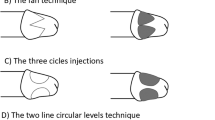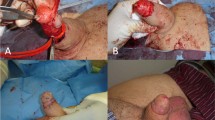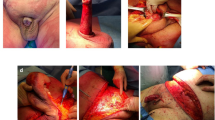Abstract
The aim of this study is to describe the outcomes for a modified glans-resurfacing technique for benign and malignant penile conditions in which the uninvolved glans corona is preserved in order to maintain glans erogenous sensation. A total of 13 patients underwent coronal-sparing glans resurfacing (CSGR), with follow-up every 3 months for ≥2 years. Positive surgical margin and local recurrence (LR) rates were evaluated. Surgical complications and cosmetic outcomes were also recorded. Patients were asked to complete the International Index of Erectile Function-5 (IIEF-5) questionnaire starting 12 months after the surgery. The median (interquartile range [IQR]) age and follow-up periods were 63 (53–68) years and 29 (14–38) months, respectively. Eight patients were diagnosed with primary penile squamous cell carcinoma (SCC), three had refractory lichen sclerosus, and two had penile intraepithelial neoplasia (PeIN). No surgical complications were recorded. All patients had a complete graft take and reported satisfactory cosmetic results with preserved erogenous sensation. Two cancer patients developed LR which was managed with further penile preserving surgery. The median (IQR) postoperative IIEF-5 value was 20 (17–23). This modified coronal-sparing technique was suitable for glans lesions that spare the coronal ridge and coronal sulcus. Preservation of the coronal ridge helps maintain sexual function and provides excellent cosmetic outcomes.
This is a preview of subscription content, access via your institution
Access options
Subscribe to this journal
Receive 8 print issues and online access
$259.00 per year
only $32.38 per issue
Buy this article
- Purchase on Springer Link
- Instant access to full article PDF
Prices may be subject to local taxes which are calculated during checkout




Similar content being viewed by others
References
Christodoulidou M, Sahdev V, Houssein S, Muneer A. Epidemiology of penile cancer. Curr Probl Cancer. 2015;39:126–36.
O’Kelly F, Lonergan P, Lundon D, Nason G, Sweeney P, Cullen I, et al. A prospective study of total glans resurfacing for localized penile cancer to maximize oncologic and functional outcomes in a tertiary referral network. J Urol. 2017;197:1258–63. https://doi.org/10.1016/j.juro.2016.12.089.
Alnajjar HM, Randhawa K, Muneer A. Localized disease: types of reconstruction/plastic surgery techniques after glans resurfacing/glansectomy/partial/total penectomy. Curr Opin Urol. 2020;30:213–7.
Garaffa G, Shabbir M, Christopher N, Minhas S, Ralph DJ. The surgical management of lichen sclerosus of the glans penis: our experience and review of the literature. J Sex Med. 2011;8:1246–53.
Shim TN, Ali I, Muneer A, Bunker CB. Benign male genital dermatoses. BMJ. 2016;354:1–11.
Charlton OA, Smith SD. Balanitis xerotica obliterans: a review of diagnosis and management. Int J Dermatol. 2019;58:777–81.
Bunker CB, Shim TN Male genital lichen sclerosus. Indian J Dermatol. 2015;60:111–7.
Ashley S, Shanks JH, Oliveira P, Lucky M, Parnham A, Lau M, et al. Human papilloma virus (HPV) status may impact treatment outcomes in patients with pre-cancerous penile lesions (an eUROGEN Study). Int J Impot Res. 2020. https://doi.org/10.1038/s41443-020-0327-4.
Hakenberg OW, Comperat E, Minhas S, Necchi A, Protzel C, Watkin N, et al. EAU guidelines on Penile Cancer. Arnhem, The Netherlands: EAU Guidelines Office; 2020. retrieved from https://uroweb.org/guidelines/.
Kravvas G, Shim TN, Doiron PR, Freeman A, Jameson C, Minhas S, et al. The diagnosis and management of male genital lichen sclerosus: a retrospective review of 301 patients. J Eur Acad Dermatol Venereol. 2018;32:91–5.
Depasquale I, Park AJ, Bracka A. The treatment of balanitis xerotica obliterans. BJU Int. 2000;86:459–65.
Shabbir M, Muneer A, Kalsi J, Shukla CJ, Zacharakis E, Garaffa G, et al. Glans resurfacing for the treatment of carcinoma in situ of the penis: surgical technique and outcomes. Eur Urol. 2011;59:142–7. https://doi.org/10.1016/j.eururo.2010.09.039.
Hadway P, Corbishley CM, Watkin NA. Total glans resurfacing for premalignant lesions of the penis: initial outcome data. BJU Int. 2006;98:532–6.
Palminteri E, Berdondini E, Lazzeri M, Mirri F, Barbagli G. Resurfacing and reconstruction of the glans penis. Eur Urol. 2007;52:893–900.
Håkansson U, Kirrander P, Uvelius B, Baseckas G, Torbrand C. Organ-sparing reconstructive surgery in penile cancer: initial experiences at two Swedish referral centres. Scand J Urol. 2015;49:149–54.
Ayres BE, Lam W, Alnajjar HM, Corbishley CM, Perry MJA, Watkin NA. Glans resurfacing—a new penile preserving option for superficially invasive penile cancer. Eur Urol Suppl. 2011;10:340.
Yang CC, Bradley WE. Neuroanatomy of the penile portion of the human dorsal nerve of the penis. Br J Urol. 1998;82:109–13.
Halata Z, Munger BL. The neuroanatomical basis for the protopathic sensibility of the human glans penis. Brain Res. 1986;371:205–30.
Sarkarati M, Rossier AB, Fam BA. Experience in vibratory and electro-ejaculation techniques in spinal cord injury patients: a preliminary report. J Urol. 1987;138:59–62.
Pryor JL, LeRoy SC, Nagel TC, Hensleigh HC. Vibratory stimulation for treatment of anejaculation in quadriplegic men. Arch Phys Med Rehabil. 1995;76:59–64.
Mitropoulos D, Artibani W, Biyani CS, Bjerggaard Jensen J, Rouprêt M, Truss M. Validation of the Clavien–Dindo grading system in urology by the European Association of Urology Guidelines Ad Hoc Panel. Eur Urol Focus. 2018;4:608–13.
Rosen RC, Cappelleri JC, Smith MD, Lipsky J, Peñ BM. Development and evaluation of an abridged, 5-item version of the International Index of Erectile Function (IIEF-5) as a diagnostic tool for erectile dysfunction. Int J Impot Res. 1999;11:319–26.
Baumgarten A, Chipollini J, Yan S, Ottenhof SR, Tang DH, Draeger D, et al. Penile sparing surgery for penile cancer: a multicenter international retrospective cohort. J Urol. 2018;199:V1233–7.
Malone PR, Thomas JS, Blick C. A tie-over dressing for graft application in distal penectomy and glans resurfacing: the TODGA technique. BJU Int. 2011;107:836–40.
Pappas A, Katafigiotis I, Waterloos M, Spinoit AF, Ploumidis A. Glans resurfacing with skin graft for penile cancer: a step-by-step video presentation of the technique and review of the literature. Biomed Res Int. 2019;2019:1–6.
Acknowledgements
AM was supported by the NIHR Biomedical Research Centre UCLH.
Author information
Authors and Affiliations
Corresponding author
Ethics declarations
Conflict of interest
The authors declare no competing interests.
Ethics statement
This is a retrospective chart review and audit of outcomes. The treatment was in line with our institutional guidelines and operational policy and approved as part of the multidisciplinary team process as part of standard management for penile lesions. All data were anonymized. All participants gave full informed consent for surgery and for the use of their anonymized data in the study. As this was a variation of our standard partial glans-resurfacing technique which is already part of the institution operational policy, this was approved as a retrospective audit to assess surgical outcomes.
Additional information
Publisher’s note Springer Nature remains neutral with regard to jurisdictional claims in published maps and institutional affiliations.
Rights and permissions
About this article
Cite this article
Cakir, O.O., Schifano, N., Venturino, L. et al. Surgical technique and outcomes following coronal-sparing glans resurfacing for benign and malignant penile lesions. Int J Impot Res 34, 495–500 (2022). https://doi.org/10.1038/s41443-021-00452-5
Received:
Revised:
Accepted:
Published:
Issue Date:
DOI: https://doi.org/10.1038/s41443-021-00452-5
This article is cited by
-
Long-term outcomes of penile squamous cell carcinoma in men age ≤50 years old compared with men >50 years old from a single tertiary referral centre: a propensity score matched analysis
International Journal of Impotence Research (2024)
-
Outcomes following radical inguinal lymphadenectomy for penile cancer using a fascial-sparing surgical technique
World Journal of Urology (2023)
-
Case report. Resurfacing van de glans penis bij therapieresistente lichen sclerosus: een weinig bekende therapeutische optie
Tijdschrift voor Urologie (2023)



